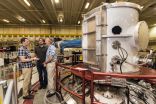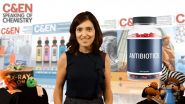(Press-News.org) EORTC investigators will present the results of their cancer research at ESMO 2014 Congress, 26-30 September 2014 in Madrid.
Joint Symposium: ESMO-ASCO: The Evolution of the clinical trial landscape
Monday, September 29, 11:00 AM - 12:30 PM, Room: Granada
Abstract 121IN: Denis Lacombe. Can Collaborative Molecular Screening Platforms support new forms of cancer clinical research? The example of the EORTC SPECTA program.
Proffered Paper session: Melanoma and other skin tumors
Saturday, September 27, 2:00 PM - 3:45 PM, Room: Barcelona
Eggermont AM, Chiarion-Sileni V, Grob JJ, Dummer R, Wolchok JD, Schmidt H, Hamid O, Robert C, Ascierto PA, Richards JM, Lebbé C, Ferraresi V, Smylie M, Weber JS, Maio M, Konto C, Karra Gurunath R, de Pril V, Suciu S, Testori A. Efficacy, safety, and quality of life data from the EORTC 18071 phase III trial of ipilimumab versus placebo after complete resection of stage III melanoma
Proffered Paper session: Sarcoma
Monday, September 29, 3:45 PM - 5:30 PM, Room: Sevilla
W.T.A. van der Graaf, A. Le Cesne, O. Mir, H. Gelderblom, A. Italiano, S. Marreaud, I. Judson, S. Litiere. Outcome of first-line treatment of elderly advanced soft tissue sarcoma (STS) patients: a pooled analysis of eleven EORTC Soft Tissue and Bone Sarcoma Group trials
Poster Discussion session: Immunotherapy of cancer
Sunday, September 28, 2014, 1:00 PM - 2:00 PM. Room: Valencia
Abstract 1056PD: Erik Tanis, Catherine Julie, Jean-Francois Emile, Bernard Nordlinger, Murielle Mauer, Arnaud Roth, Manfred Lutz, Daniela Aust, Theo Ruers. Prognostic impact of immune response in resectable colorectal liver metastases treated with and without perioperative FOLFOX chemotherapy
Poster Discussion session: Gastrointestinal tumours, colorectal
Saturday, September 27, 1:00 PM - 2:00 PM, Room: Granada
Abstract 505PD: H-J. Schmoll, K. Haustermans, T. Price, B. Nordlinger, R.D. Hofheinz, J-F. Daisne, J. Janssens, B. Brenner, P. Schmidt, H. Reinel, S. Hollerbach, K. Caca, F. Fauth, C.V. Hannig, J. Zalcberg, N. Tebbutt, M.E. Mauer, C. Messina, M.P. Lutz, E. Van Cutsem. Preoperative chemoradiotherapy and postoperative chemotherapy with capecitabine +/- oxaliplatin in locally advanced rectal cancer: interim analysis for disease free survival of PETACC-6
ESMO-SEOM Joint Symposium
Monday, September 29, 2:15 PM - 3:45 PM, Room: Granada
Abstract 150IN: D.A. Lacombe. The European Perspective of Academic Research: The way to move forwards
Poster Display session: Melanoma and other skin tumours
Monday, September 29, 1:00 PM - 2:00 PM, Room: Valencia
Abstract 1089PD: S. Suciu, A.M.M. Eggermont, P. Lorigan, J. Kirkwood, S. Markovic, C. Garbe, D. Cameron, S. Kotapati, C. Konto, T.-T. Chen, K. Wheatley, N. Ives, G. De Schaetzen, A. Efendi, M. Buyse. Relapse-free survival (RFS) as a surrogate endpoint for overall survival in adjuvant Interferon trials in patients with resectable cutaneous melanoma: an individual patient data meta-analysis
Poster Display session
Saturday, September 27, 12:45 PM - 1:45 PM, Room: Poster area
Abstract 1244PD: Mary 0'Brien, Rabab Gaafar, Baktiar Hasan, Jessica Menis, Tanja Cufer, Sanjay Popat, Penella Woll, Veerle Surmont, Vassilis Georgoulias, Ana Montes, Fiona Blackhall, Ivo Hennig, Gerald Schmid-Bindert, Paul Baas, on behalf of the EORTC Lung Cancer Group. Double blind randomized phase III study of maintenance Pazopanib® versus Placebo in non-Small Cell Lung Cancer patients non progressive after first line chemotherapy (EORTC Lung Cancer Group, 08092): MAPPING
Patient Advocacy Track
Anastassia Negrouk and Denis Lacombe will participate in the 2014 ESMO Patient Advocacy Track.
Saturday, September 27, 10:10 – 10:25, Room: Palma
Anastassia Negrouk. Pros and Cons of new EU Clinical Trials Regulation
Saturday, September 27, 10:45 – 11:30, Room: Palma
Anastassia Negrouk. Regulatory process to involve patients in discussions on clinical trial endpoints
Saturday, September 27, 11:50 – 12:00, Room: Palma
Denis Lacombe. How can patients be involved in protocol development?
Rare Cancers Europe: Special Session: How CT could have been done, and where not, in rare cancers
Monday, September 29, 16:00 – 17:30, Room: Bilbao
Jan Bogaerts. Methodological challenges in rare cancers
INFORMATION: END
EORTC presentations at ESMO 2014 Congress
2014-09-23
ELSE PRESS RELEASES FROM THIS DATE:
Opportunities to reduce patient burden associated with breast cancer screening
2014-09-23
New Rochelle, NY, September 23, 2014—New technology and better screening strategies can lower the rate of false-positive results, which impose a substantial financial and psychological burden on women. The many misperceptions about breast cancer screening options and risks, the benefits and costs of screening, and the need for new approaches and better education are discussed in a series of articles in a supplement to Journal of Women's Health, a peer-reviewed publication from Mary Ann Liebert, Inc., publishers. The supplement is available free on the Journal of Women's ...
2014 Arctic sea ice minimum sixth lowest on record
2014-09-23
Arctic sea ice coverage continued its below-average trend this year as the ice declined to its annual minimum on Sept. 17, according to the NASA-supported National Snow and Ice Data Center (NSIDC) at the University of Colorado, Boulder.
Over the 2014 summer, Arctic sea ice melted back from its maximum extent reached in March to a coverage area of 1.94 million square miles (5.02 million square kilometers), according to analysis from NASA and NSIDC scientists. This year's minimum extent is similar to last year's and below the 1981-2010 average of 2.40 million square miles ...
Actions on climate change bring better health, study says
2014-09-23
MADISON, Wis. — The number of extremely hot days in Eastern and Midwestern U.S. cities is projected to triple by mid-century, according to a new study led by University of Wisconsin-Madison researchers and published today in the Journal of the American Medical Association.
Milwaukee and New York City could experience three times as many 90-degree days by 2046; Dallas could see twice as many days topping 100 degrees. The new analysis offers climate data through the lens of public health, in a study that represents a synthesis of the latest science at the intersection of ...
Sandia magnetized fusion technique produces significant results
2014-09-23
ALBUQUERQUE, N.M. — Researchers at Sandia National Laboratories' Z machine have produced a significant output of fusion neutrons, using a method fully functioning for only little more than a year.
The experimental work is described in a paper to be published in the Sept. 24 Physical Review Letters online. A theoretical PRL paper to be published on the same date helps explain why the experimental method worked. The combined work demonstrates the viability of the novel approach.
"We are committed to shaking this [fusion] tree until either we get some good apples or a ...
Critically ill ICU patients lose almost all of their gut microbes and the ones left aren't good
2014-09-23
Researchers at the University of Chicago have shown that after a long stay in the Intensive Care Unit (ICU) only a handful of pathogenic microbe species remain behind in patients' intestines. The team tested these remaining pathogens and discovered that some can become deadly when provoked by conditions that mimic the body's stress response to illness.
The findings, published in mBio®, the online open-access journal of the American Society for Microbiology, may lead to better monitoring and treatment of ICU patients who can develop a life-threatening systemic infection ...
Video blinds us to the evidence, NYU, Yale study finds
2014-09-23
Where people look when watching video evidence varies wildly and has profound consequences for bias in legal punishment decisions, a team of researchers at New York University and Yale Law School has found. This study raises questions about why people fail to be objective when confronted with video evidence.
In a series of three experiments, participants who viewed videotaped altercations formed biased punishment decisions about a defendant the more they looked at him. Participants punished a defendant more severely if they did not identify with his social group and punished ...
AWHONN recommends reducing overuse of labor induction
2014-09-23
Washington, DC, September 23, 2014 —The Association of Women's Health, Obstetric and Neonatal Nurses (AWHONN) is calling upon healthcare providers and pregnant women to avoid induction of labor at any time during pregnancy unless it is medically necessary.
Approximately one-in-four U.S. births are induced, a number that has more than doubled since 1990. While there are limited data to distinguish how many of these inductions are for medical and non-medical reasons, there is no data to suggest that the significant increase in the induction rate is attributable to a similar ...
New measure provides more data on oxygen levels during sedation
2014-09-23
September 23, 2014 – The "area under the curve of oxygen desaturation" (AUCDesat) may provide a more sophisticated approach to monitoring blood oxygen levels during procedures using sedation, according to a study published in Anesthesia & Analgesia.
The AUCDesat provides information not only whether blood oxygenation has dropped too low—but also on the depth, duration, and rate of episodes of oxygen desaturation. The new study by Paul Niklewski, PhD, of University of Cincinnati and colleagues reports on the development of the AUCDesat as a potentially useful new approach ...
Termites evolved complex bioreactors 30 million years ago
2014-09-23
Achieving complete breakdown of plant biomass for energy conversion in industrialized bioreactors remains a complex challenge, but new research shows that termite fungus farmers solved this problem more than 30 million years ago. The new insight reveals that the great success of termite farmers as plant decomposers is due to division of labor between a fungus breaking down complex plant components and gut bacteria contributing enzymes for final digestion.
Sophisticated Management in Termite Fungus Farms
Fungus-farming termites are dominant plant decomposers in (sub)tropical ...
Speaking of Chemistry: Why we need antibiotics (video)
2014-09-23
WASHINGTON, Sept. 23, 2014 — Antibiotics revolutionized health care in the early 20th century, helping kill bacteria that once killed thousands of people. But bacteria are also constantly outsmarting science, and new strains of antibiotic-resistant bacteria are popping up more frequently. This week's Speaking of Chemistry focuses on the current shortage of new antibiotics and discusses the prospects for new drugs. The episode also answers the question: Why should you finish your pills if you feel better? Check it out at: http://youtu.be/MAoDuSxXIUQ.
Antibiotics are just ...



